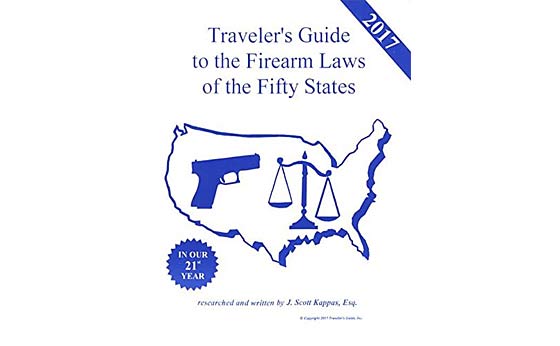Transporting Firearms Across State Lines | Travelers Guide

The following important information about transporting firearms across state lines is sourced from the NRA-ILA. I’ve also referenced an excellent travelers guide for transporting firearms across state lines. I have used this guide for my own trip planning. I’ll show you that first…
I have found the following guide to be extremely useful, “Traveler’s Guide to the Firearm Laws of the Fifty States”.
Each state is covered separately. The guide will inform you of each state’s (perhaps unique) firearm laws. There’s also an up-to-date list of ‘carry’ license reciprocity between states.
Guide to Transporting Firearms Across State Lines
The guide is updated each year with any changes to law. It was very helpful for me during a recent long road trip:
UPDATED GUIDE (2021)
Traveler’s Guide to the Firearm Laws of ALL 50 States
(view on amzn)
CAUTION: Federal and state firearms laws are subject to frequent change. This summary is not to be considered as legal advice or a restatement of law. To determine the applicability of these laws to specific situations which you may encounter, you are strongly urged to consult a local attorney.
Federal law does NOT restrict individuals from transporting legally acquired firearms…
… across state lines for lawful purposes except those explicitly prohibited by federal law to include convicted felons; persons under indictment for felonies; adjudicated “mental defectives” or those who have been involuntarily committed to mental institutions; illegal drug users; illegal aliens and most non-immigrant aliens; dishonorably discharged veterans; those who have renounced their U.S. citizenship; fugitives from justice; persons convicted of misdemeanor crimes of domestic violence; and persons subject to certain domestic violence restraining orders.
Therefore, no federal permit is required (or available) for the interstate transportation of firearms.
HOWEVER…
Many states and localities have laws governing the transportation of firearms
Travelers must be aware of these laws and comply with legal requirements in each jurisdiction. There is no uniform state transportation procedure for firearms.
If in doubt, a traveler should carry firearms unloaded, locked in a case, and stored in an area (such as a trunk or attached toolbox) where they are inaccessible from a vehicle’s passenger compartment and not visible from outside the vehicle. Any ammunition should be stored in a separate locked container. Title 18 Part 1 Chapter 44 s926A
FEDERAL LAW ON TRANSPORTING FIREARMS ACROSS STATE LINES
A provision of the federal law known as the Firearms Owners’ Protection Act, or FOPA, protects those who are transporting firearms for lawful purposes from local restrictions which would otherwise prohibit passage.
Under FOPA, notwithstanding any state or local law, a person is entitled to transport a firearm from any place where he or she may lawfully possess and carry such firearm to any other place where he or she may lawfully possess and carry it, if the firearm is unloaded and locked out of reach.
In vehicles without a trunk, the unloaded firearm must be in a locked container other than the glove compartment or console. Ammunition that is either locked out of reach in the trunk or in a locked container other than the glove compartment or console is also covered.
Travelers should be aware that some state and local governments treat this federal provision as an “affirmative defense” that may only be raised after an arrest.
All travelers in areas with restrictive laws would be well advised to have copies of any applicable firearm licenses or permits, as well as copies or printouts from the relevant jurisdictions’ official publications or websites documenting pertinent provisions of law (including FOPA itself) or reciprocity information.
CARRYING ON OR ABOUT THE PERSON
As soon as any firearm is carried on or about the person, or placed loaded or readily accessible in a vehicle, state and local laws regarding the carrying of firearms apply. If you seek to carry or transport firearms in such a manner, it is advisable that you determine what the law is.
(The Guide referenced above will assist in this determination)
TRANSPORTATION BY MOTOR VEHICLE
In most states, firearms may be transported legally if they are unloaded, cased, and locked in the automobile trunk or otherwise inaccessible to the driver or any passenger.
The exceptions to this rule apply mainly to transportation of handguns and so-called “assault weapons.” The myriad and conflicting legal requirements for firearm transportation through the states make caution the key for travelers of which you must consult local law.
(The Guide referenced above will assist in this determination)
Do you travel with a trailer or camper pulled by a vehicle? It is advisable to transport the firearms unloaded, cased and locked in the trunk of the car. No trunk (e.g. a truck)? It is advised to keep the locked box as ‘out of reach’ as possible. Inaccessible to the driver or any passenger.
If your vehicle is of the type in which driving and living spaces are not separated (RV), the problem becomes one of access. If the firearm is carried on or about the person, or placed in the camper where it is readily accessible to the driver or any passenger, state and local laws regarding concealed carrying of firearms may apply.
It is recommended, therefore, that the firearm be transported unloaded, cased, and placed in a locked rear compartment of the camper or mobile home, where it is inaccessible to the driver or any passenger.
Once you reach your destination, state and local law will govern the ownership, possession, and transportation of your firearms.
